(1) How long have the Plantronics Wireless Headsets been sitting in a warehouse?
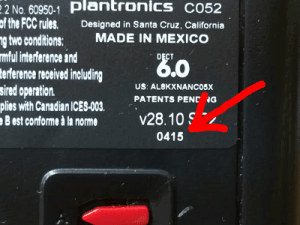

Plantronics wireless headsets use rechargeable batteries, and getting ‘a deal’ could mean you’re getting a new product, but with old batteries that won’t hold a charge, you will be shorting the valuable talk-time you’re expecting. This causes you wasted time and money, having to replace the batteries before you can put your new headset into operation. Most people don’t realize a date code is stamped on the outside of the box as well as the headset/base. If you’re purchasing from a new source and haven’t established any trust with the company, have them take a picture and email you the date code from the box to give you peace of mind that you’re really getting new product with fresh batteries.
Why is battery life critical? If we take the popular Plantronics CS540, the specification sheet shows a talk time of 7 hours. Every time you push the button on the headset to talk, you are using your battery. That 7 hours will get most users through even the busiest of days. But as with any rechargeable battery, it’s being drained and recharged every day, and over time the battery wears out and holds less charge, which means less talk time on a wireless headset. All wireless headsets will start beeping when the battery is getting low to warn you it’s time to switch to your handset and put your wireless headset into the base for charging. It’s not an exact science, but after a year of use, you may notice your headset starts beeping after 6 hours of use. Another year and now you’re down to 5 hours before you need to re-charge it. If you start with a unit that’s been sitting in the warehouse for 2-3 years since being manufactured, you may start with a fraction of the expected talk time, causing you the expense of a replacement battery much sooner than expected. Most Plantronics replacement batteries will cost $35-40.
A few Plantronics models are made where the battery is not replaceable, and the entire headset must be replaced. This is much more expensive, approximately $140-150, and may be impossible if the model has been discontinued. If you happen to purchase an old product, and the battery doesn’t hold a sufficient charge, you will be purchasing more replacement parts than you bargained for.
(2) Is the Plantronics product you’re buying genuine or a cheap knock-off?
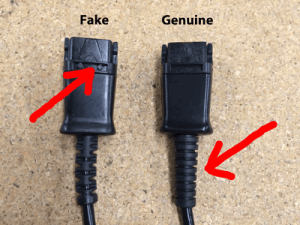
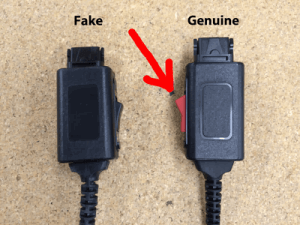
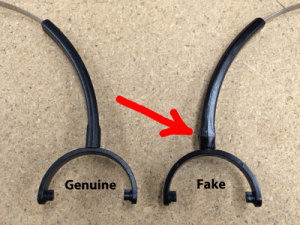
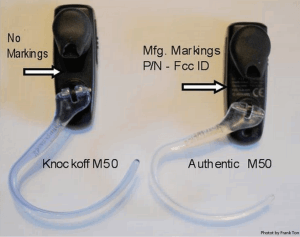
It’s becoming very common to find knock-off headsets and accessories at a fraction of the price. Customers regularly share with us their problems of static, volume issues, and products that simply don’t hold up with normal use. When you see a Plantronics headset priced too good to be true…it most likely is! Stay clear of those types of bargains and save yourself wasted time, money, and grief.
Fake headsets can be difficult to spot and may work just fine, initially. But eventually it will become apparent that the money you tried to save was actually money wasted. On corded headsets, the rubber grommets that provide cord strain relief will look different from genuine Plantronics products. Y-cords for training often have a black toggle switch instead of the traditional red. Headbands will be tapered (bulge outward and thicker) and hard to turn versus genuine products. You will also see plastic nubs left behind on the quick disconnect connection on fake products, where the manufacturer didn’t have a high quality mold or didn’t take the time to remove or shave off leftover attachment points.
Customer experiences with fake bottom cables have crippled small companies, large corporations, and call centers alike. What appears to be the same product as being offered by an authorized Plantronics distributor for half the price starts causing static and disconnects callers, sending you in circles troubleshooting before you realize what the issue is.
(3) Are you dealing with a Headset Expert?

Find someone that can help you and not just sell you. Choosing the right headset is not easy with a lot of variables and compatibility issues. You need someone who knows about compatibility, office noise, wearing options, and other important factors. Most importantly, you’re going to need help with pre-sale questions, support with setup, and after the sale, assistance, if a unit should stop working. Finding someone that understands headsets will save you several hours of researching on your own, guessing what you need, and shipping wrong items back and forth. A Headset Expert will know the correct questions to ask in order to learn about your current problems and challenges, ensuring you find the right solution to meet your needs.
Key discussion points:
- Headset Compatibility
- Loud vs. Quiet Office Settings
- Wearing Options and Styles
- Corded vs. Wireless
- Lowest Price Equals No Service/Support
- Availability and Delivery
- Warranty Support
All sales representatives are your best friend leading up to the sale. But what happens if your new headset doesn’t work once you receive it? Is your original sales representative able to offer assistance to get you up and going? Or do they push you to someone else, or worse, tell you to contact the manufacturer directly and “Good Luck!”. What happens if you have a defective unit right out of the box? Are you responsible for paying for shipping back and forth? And what are you getting as a replacement, hopefully a new item and not a re-manufactured unit. These are all items to discuss with your sales representative before you commit to a sale. Buying from the ‘low-price’ company usually means that’s all you get…a low-price. Headsets are hi-tech, electronic devices, and it’s worth paying 5-10% over that ‘low-price’ quote to work with a company where you have confidence in their products and service.
(4) What is the risk of buying from an online auction?
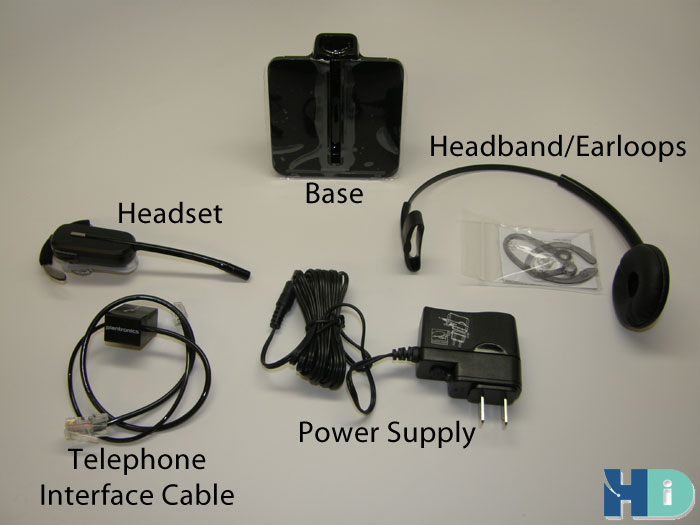
We constantly have customers calling that say they can’t wait to use their new Plantronics headset they purchased from an online auction, but unfortunately when it arrived, it was missing necessary cables, power supplies, or they simply can’t get it to work. Additionally, they’ve spent hours trying to track down the company from which they purchased the product, and the company won’t return their calls or emails. By the time they purchase the missing pieces, they feel taken and have spent more money than if they had purchased a new product from an authorized dealer. Online auctions are typically a way to liquidate products, and rarely does the person putting the items up for bid know what’s suppose to be in the box. That missing cord you need was most likely thrown in the box of phones they sold in a separate auction. They also don’t have a way to test the unit to ensure it’s in good working order. You will also run into issues where the headsets were used on a different type of phone than yours, and you’re simply not getting a compatible product.
Another concern is what are you actually buying. If it’s new in the box, exactly how new is it? You may be buying a 2-3 generation old product that doesn’t meet new product standards, quality, or advances. A battery also has a shelf life, and if you’re buying a 5-year-old item, you will be replacing a battery a lot sooner than you would like. If it’s used equipment, why are they getting rid of it? Are you getting stuck with all the broken units and/or units with issues? Lastly, when a company is liquidating products that were in use, from a hygienic point of view, are you sure you want used ear cushions, voice tubes, and ear gels?
(5) Which is better Over-the-Ear, Monaural, Binaural or Convertible headsets?

Customers often ask which headset is best, and that’s really not a fair question. What’s best for you may not be best for someone else. It depends on your environment and your personal wearing style preference.
As you can see from our chart, convertible headsets are the most popular. They give users the most flexibility, trying different wearing options and selecting what fits most comfortably. Convertible headsets are also light weight compared to headband models, being another reason users naturally gravitate towards them. Most Plantronics convertible headsets have a replaceable battery, extending the life of the headset, giving you great value for long-term use for your headset investment. Convertible wireless headsets use a smaller ear cushion (headband wearing option) and ear gels (over-the-ear wearing option), making them better suited for medium-to-quiet office environments.
Over-the-Ear headsets are great for users wanting a secure, low-profile headset that will be used in a medium-to-quiet environment. With the battery and circuitry hidden behind your ear, face-to-face conversations are distraction free, and you won’t feel self conscious wearing a headset in front of others. With the headset on one ear, your other ear is open to your office, so you may easily interact with co-workers, and you will be able to hear what’s going on within the office. Most over-the-ear wireless headsets do not have a replaceable battery, which may affect your choice of headsets. When your talk time gets to a point where you can’t get through the day without recharging your headset, you will need to purchase a replacement headset with a fresh battery. It’s definitely more money to replace the entire headset versus only a battery, as with other models. Your decision of an over-the-ear headset will come down to choosing a light-weight, low profile headset or a headset with a replaceable battery.
Over-the-head models will provide longer talk times, a slightly more secure fit, and a little better sound quality due to larger speakers resting against your ear. The monaural version works well in the medium-to-quiet environments allowing you to stay in touch with your office and easily talk to coworkers. As your environment becomes louder, the noise-canceling microphone will focus on your voice more and cut down on background noise, allowing your caller to hear your voice more clearly.
Binaural wireless headsets are excellent for users in loud environments or when they want to be more isolated and have complete focus on their callers. Covering both ears will also isolate you from what’s going on in your office, but you can easily slide it off and rest it around your neck between calls to engage your co-workers.
Call Us With Any Questions: 1-800-914-7996

Thank you for validating my suspicions when buying Plantronics through the years. Wondering if I actually purchased a “second” or 1st quality item. Quite unnerving.